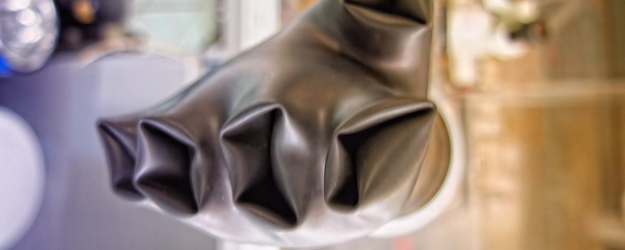6 March 2012
Under the name 'campus digital', five experienced amateur photographers have taken it upon themselves to capture as many facets of the university as possible on film. The group puts on a new exhibition every six months. Their latest show, 'laboratories’, has just opened.
Decades-old syringes are loosely strung against a light background. Their glass bodies sparkle; steel needles loom in the darkness. The inverted fingers of a safety glove reach out to the viewer. It seems that only moments ago they were caressing the hands of a researcher; now they are only five empty rubber tubes. The laboratory has seen better days. The white tiles shine with a lackluster glow, a cold light reveals signs of wear on the furniture and equipment. Paint is peeling from the walls.
"We take so many private photos for ourselves, and then they eventually get stored on a hard drive without being seen," says Rosita Reindel. She works as a construction technician for the Estate Management Office at Johannes Gutenberg University Mainz (JGU). She and her colleague from Technical Services, Ruth Adam, share a passion: photography.
Tulips in soft focus
In February 2007, the two women looked at their digital image library and came up with an idea: "Maybe we should hold an exhibition!" Jürgen Dietrich, also from Technical Services, joined them, and the group 'campus digital' was born.
Reindel asks her colleague: "Do you remember how you took a photograph showing a lot of small tulips and then used soft focus to provide a distancing effect - rather in the style of David Hamilton?" No, Dietrich doesn't recall that, but does certainly remember the insight he gained. "At that time, we were starting to explore what each of us could do."
And now in February 2012, 'campus digital' is putting on its new exhibition 'laboratories' in the University's Technical Operations Center. Volker Faust of Technical Services became the fourth member of the group. It is preview day, and he recalls: "We told ourselves: Everyone takes photographs, so what? But we all work at the University; why don't we take pictures of where we work?"
Huge pipes under the campus
From then on, hardly any corner of the campus was safe from 'campus digital'. The group photographed huge underground pipes and tunnels, turned the spotlight on those who otherwise work in secret, and also explored an old heating and power station. This led to exhibitions, such as 'art in construction', 'facilities', and 'employees in the background'. "It's great that this opened doors for us everywhere," says Adam, "and this is something that is not simply a matter of course."
One of her photos depicts a glass with a bright blue liquid in which a whirl can be seen. The trained graphic designer pays considerable attention to details. "She kept maneuvering herself around that glass for half an hour before she could capture the exact image she wanted," explains Reindel. Dietrich, however, takes a quite different approach. "I take pictures almost without thinking." Then the extensive computer work begins. "I don't really like to edit my photos," states Jürgen Hofmann of the Estate Management Office. He was the fifth and final member to join 'campus digital'.
Every photographer has his or her quirks
"We have all learned to live with one another's various quirks," claims Reindel. The five photographers see each other frequently, and their exhibitions demonstrate their high level of commitment, but they have never wanted to work within a more fixed structure. Everything is done informally without the need of a straitjacket of rules and regulations. "Of course we review each other's work," says Faust, talking about their meetings, "but that's really stimulating. We have learned a tremendous amount in the last five years."
The 'laboratories' exhibition reflects the group's informal structure in many ways. Playful photos of unexpected details alternate with images that have more of a documentary effect. Angles are cleverly used to alienate the everyday and capture facets of university life that could soon be irretrievably lost. The University's Vice President, Professor Dr. Ulrich Förstermann, present at the opening of the exhibition, sums up: "This group of amateur photographers have by now managed to adopt professional skills."
Second place in JGU Ideas Competition
The judges who awarded 'campus digital' the second prize in the JGU Ideas Competition were obviously thinking along similar lines. The University asked for the submission of concepts that could be used to epitomize the motto of the University's institutional strategy 'The Gutenberg Spirit: Moving Minds – Crossing Boundaries' in a particularly original way. 'Campus digital' not only submitted its own photos but also suggested that visual material of the most diverse types should be combined and made accessible to the public.
"Winning this award has given us a lot of encouragement," states Hofmann. The money will be used to support the work of 'campus digital'; the group already has various plans for new ventures. "Our next project will be called 'underground,'" reveals Reindel.
Next station: underground
But for the present, the 'laboratories' exhibition will be on display for the next six months: The orange-colored garbage can filled to the brim with old test tubes, the ultra-modern microscope from the Institute of Molecular Biology that glistens as if it has never been touched. And the blue umbrella, hanging to dry under a ventilation shaft.



